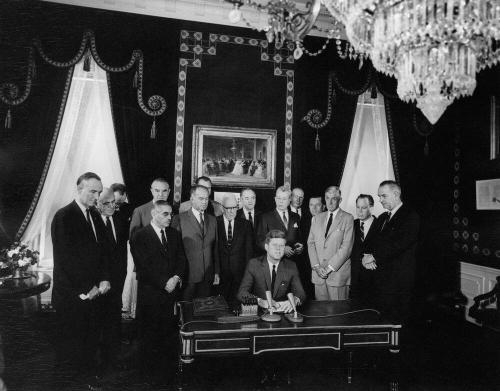The Washington defense and security communities are abuzz with press reports regarding possible presidential decisions on U.S. nuclear weapons numbers. Administration officials say the president has not yet seen the options that the National Security Council is preparing with the Defense Department and others, let alone made a decision.
What’s the background? In April 2010, the Department of Defense issued a Nuclear Posture Review. That document described how the administration planned to reduce the role of nuclear weapons in U.S. security policy while at the same time maintaining strategic deterrence and stability, and strengthening regional deterrence. Shortly thereafter, Presidents Obama and Medvedev signed the New Strategic Arms Reduction Treaty (New START), which limits the United States and Russia each no more than 1550 deployed strategic warheads on no more than 700 deployed strategic missiles and bombers. The treaty entered into force in February 2011, and its implementation is well underway.
More than anything else in the U.S. arsenal, nuclear weapons are the president’s weapons. He (or she) must authorize their use, in what would be one of the most momentous decisions that a president could take. The process now underway is examining alternative approaches to deterrence. It will conclude with the president deciding on guidance as to what is needed for deterrence, on how and to what end nuclear weapons would be used, should that be necessary. The Department of Defense and Strategic Command will then translate that guidance into a specific nuclear force structure and number of weapons.
Several options for what that guidance would look like, along with illustrative strategic nuclear force structures, are being prepared for the president’s review. Those force structures reportedly run from something like the current structure to options that would cut the number of deployed strategic warheads to levels well below those in New START. Some observations:
First, it is appropriate to conduct this review. The current U.S. strategic nuclear force structure is based on presidential guidance approved more than eleven years ago. U.S. officials ought to be asking what it takes today to maintain an effective deterrent. That includes questions such as: What targets of value to a potential adversary should U.S. nuclear forces hold at risk in order to deter that adversary? How many nuclear weapons are needed to hold those targets at risk, allowing for the possibility that the adversary might consider striking first? Would some adversaries be better deterred by more usable military options, such as Predators with Hellfire missiles that could target individual leaders? And so on. Getting these calculations right should produce a policy and a force structure capable of deterring potential adversaries.
Some critics of New START (and arms control in general) claim that 1550 deployed strategic warheads is already too low for deterrence, but they do not say who is not deterred by that force. If the president and his senior civilian and military advisors conclude that the United States can maintain an effective deterrent at a number below 1550, it would be logical to consider going below New START levels.
Second, it is a smart time to conduct this review. Over the next several years, Washington will have to make important and expensive decisions about recapitalizing all three legs of the U.S. strategic triad—intercontinental ballistic missiles, ballistic missile submarines and nuclear-capable heavy bombers. Those decisions will shape the strategic force for decades. It would be wise to have a policy in place to guide those decisions rather than having them driven simply by budget considerations. That is especially true when defense resources are tight, and the Pentagon wants to buy other equipment—ships, aircraft and ground combat vehicles—for military operations that are far more likely than nuclear war.
Third, whatever policy the president chooses—and whatever force structure and number of nuclear warheads follow from that policy—it is an entirely separate question how the United States chooses to get to that level. One way would be to do so unilaterally. Should Washington conclude that X deployed strategic warheads suffice to deter any potential adversary, should we worry about the number of weapons that other countries have? The George W. Bush administration decided in 2001 that deterrence required 1700-2200 operational strategic warheads, said that it did not care how many nuclear weapons Russia or China kept, and over the following eight years unilaterally cut the U.S. nuclear arsenal in half.
Alternatively, Washington could decide to implement a new level through an arms control arrangement. The president might choose to reduce U.S. nuclear forces only if Russia and possibly other countries reduced theirs as well.
I personally believe that the security of the United States and its allies could be safely maintained with fewer nuclear weapons than we have today. The current U.S. force structure, while significantly smaller than what the United States maintained 20 years ago, still looks awfully Cold War-like. The president and his senior national security advisors need to work through the complex deterrence questions, but it seems that we have more than we need to deter a rational potential adversary. And if an irrational potential adversary is not deterred by 1550 nuclear warheads, we should look at some other deterrence mechanism, since 5000 or 10,000 warheads likely will not deter him either. The review is the opportunity for the president to consider these very serious and consequential issues with his senior advisors and render his judgment.

Commentary
President Obama, Deterrence and Nuclear Weapons
February 16, 2012